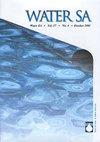Groundwater contaminant fluctuation at a landfill: a case study of the Coastal Park Landfill, Cape Town
IF 1
4区 环境科学与生态学
Q4 WATER RESOURCES
引用次数: 0
Abstract
Rainfall has been shown to be the main cause of elevated nutrient pollution in groundwater beneath landfills. However, groundwater monitoring is often based on predetermined schedules without considering rainfall patterns. This study examined how rainfall patterns affect fluctuations in groundwater quality at the Coastal Park landfill in Cape Town, South Africa, and the relevance of current groundwater sampling schedules. Boreholes upstream and downstream of two large waste cells, one lined and the other unlined, were monitored for 15 weeks during the onset of the rainy season to detect changes in the groundwater level, pH, conductivity, dissolved oxygen, ammonia, nitrate, and phosphate. Rainfall patterns strongly affected the groundwater parameters, with widely varying fluctuation patterns and lag times. Conductivity peaked downstream of the lined cell 10 weeks later than at the unlined cell, with widely different fluctuation patterns (R2 = 0.36). Ammonia peaked downstream of both the unlined and lined cells well before the early rains, with very similar fluctuation patterns (R2 = 0.97), although it peaked 6 times higher in the unlined cell. Nitrate peaked at Weeks 2 to 4 downstream of the unlined and the lined cell, with a weak correlation (R2 = 0.56). A shorter nitrate peak and a net decrease throughout the rainy season were observed downstream of the lined cell. Phosphate showed a brief, multi-fold increase at Week 3 downstream of both the unlined and lined cells, displaying pH-induced mobilisation and a very strong correlation (R2 = 0.99) between these locations. Lag times and fluctuation patterns varied depending on the presence of liners, and rainfall patterns. Therefore, the low frequency sampling required by many South African landfill waste management permits and licences cannot identify pollutant peak concentrations or describe their trends, and high frequency sampling should be considered.垃圾填埋场地下水污染物波动:开普敦海岸公园垃圾填埋场案例研究
降雨是垃圾填埋场地下水营养污染加剧的主要原因。然而,地下水监测通常是根据预先确定的时间表进行的,没有考虑降雨模式。本研究考察了降雨模式如何影响南非开普敦海岸公园垃圾填埋场地下水质量的波动,以及当前地下水采样计划的相关性。在雨季来临时,对两个大型垃圾池(一个有衬里,另一个没有衬里)上下游的钻孔进行了为期 15 周的监测,以检测地下水位、pH 值、电导率、溶解氧、氨氮、硝酸盐和磷酸盐的变化。降雨模式对地下水参数影响很大,波动模式和滞后时间差异很大。有衬砌水池下游电导率达到峰值的时间比无衬砌水池晚 10 周,波动模式也大不相同(R2 = 0.36)。氨氮在早期降雨之前就在无衬砌和有衬砌水池下游达到峰值,波动模式非常相似(R2 = 0.97),但无衬砌水池的峰值比有衬砌水池高出 6 倍。硝酸盐在无衬砌和有衬砌小区下游第 2 至 4 周达到峰值,相关性较弱(R2 = 0.56)。在有衬砌水池的下游,硝酸盐峰值较短,且在整个雨季都呈净下降趋势。在第 3 周,无衬里和有衬里池塘下游的磷酸盐都出现了短暂的数倍增长,显示出 pH 诱导的移动,并且这些地点之间存在很强的相关性(R2 = 0.99)。滞后时间和波动模式因衬里的存在和降雨模式而异。因此,许多南非垃圾填埋场废物管理许可证和执照所要求的低频率采样无法确定污染物的峰值浓度或描述其趋势,因此应考虑高频率采样。
本文章由计算机程序翻译,如有差异,请以英文原文为准。
求助全文
约1分钟内获得全文
求助全文
来源期刊

Water SA
环境科学-水资源
CiteScore
2.80
自引率
6.70%
发文量
46
审稿时长
18-36 weeks
期刊介绍:
WaterSA publishes refereed, original work in all branches of water science, technology and engineering. This includes water resources development; the hydrological cycle; surface hydrology; geohydrology and hydrometeorology; limnology; salinisation; treatment and management of municipal and industrial water and wastewater; treatment and disposal of sewage sludge; environmental pollution control; water quality and treatment; aquaculture in terms of its impact on the water resource; agricultural water science; etc.
Water SA is the WRC’s accredited scientific journal which contains original research articles and review articles on all aspects of water science, technology, engineering and policy. Water SA has been in publication since 1975 and includes articles from both local and international authors. The journal is issued quarterly (4 editions per year).
 求助内容:
求助内容: 应助结果提醒方式:
应助结果提醒方式:


